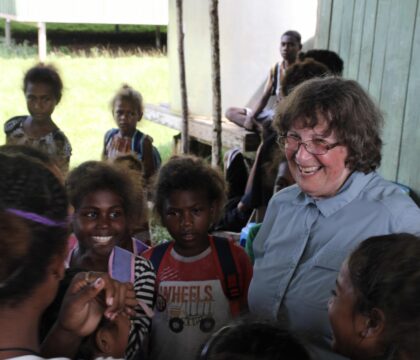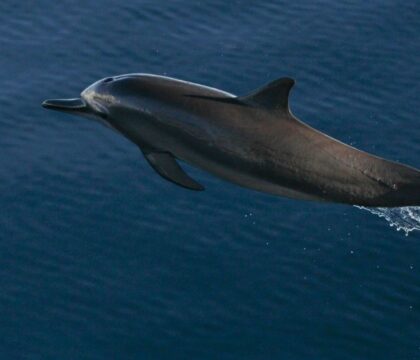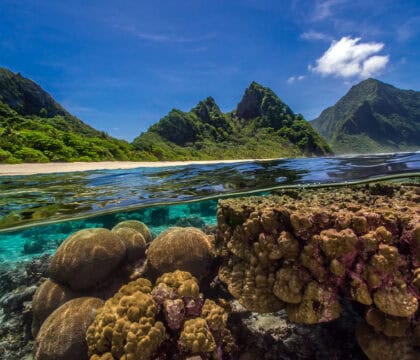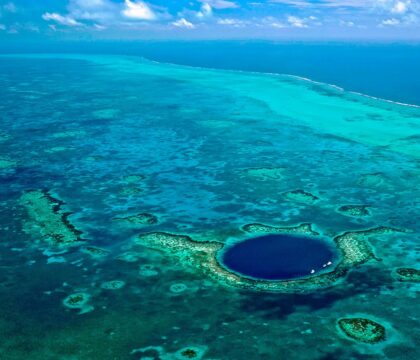March 20, 2018 • News Announcements
The Sixth International Marine Debris Conference (6IMDC) just convened in San Diego (March 12-16, 2018) with an impressive sold out capacity of 700+ attendees from 54 countries and another 250 on the waiting list. The previous 5IMDC was held a long seven years ago in Honolulu.
What is the state of affairs in the world of plastic pollution? One indication is that even though “plastic pollution” has entered the common parlance the world over, it is still being called marine debris, litter, and trash by governmental leaders and conference organizers. But make no mistake, plastic pollution’s handprints were everywhere: it was quantified, analyzed, dissected, and reformed into everything from bracelets to the requisite plastic sea turtle and some interesting large-scale bottle-shaming inflatable sculptures by Cruder and LaPenta.
Inflatable bottle sculpture by Cruder and LaPenta.
A new generation of young scientists are now fully fledged publishing researchers, the second wave of plastic research. At the conference, the words of the day are microplastic and microfibers. In a just-published groundbreaking global study led by Abigail Barrows with Adventure Scientists, a global citizen-science sampling army collected surface-level whole water catches that were analyzed back in Barrows’ Maine lab. 87% of the water samples taken had plastic contamination, and of this, 91% were microfibers from the ubiquitous synthetic apparel that has been worn worldwide for decades. Of course, these fibers are not only in the ocean, in rivers, and in streams, they are also airborne. So, one of the primary human health concerns from these fibers concerns inhalation, according to Dutch ecotoxicologist Dick Vethaak of Deltares. But what is airborne eventually settles, making the ocean the ultimate repository for these plastic fibers. In synchrony, on March 12 the World Health Organization published a study that found widespread contamination of microfibers of polypropylene, nylon, and polyethylene terephthalate (PET) in globally sampled bottled drinking water. To the researchers and activists on the ground, this comes as no surprise. We are the ocean and the ocean is inside of us. But this is just the kind of news we need to shock the greater public into action.
Closest to my heart are the plastic warriors the world over who do the back-breaking physical labor of macroplastic coastal removal. These community organizers are the front line (and the last ditch intervention point) of preventing further entanglement and ingestion by marine wildlife, and further contamination of the ocean and coastal environment. This effort cannot be underestimated, as the removal of each single piece of plastic prevents the release of hundreds if not thousands of pieces of microplastic once degradation begins. The hard-core crew of Kauai Surfrider‘s Net Patrol, led by Barbara Widener, single-handedly removed 123,000 pounds of ocean plastic, more than half of which were derelict nets from that one island’s shores, an astonishing effort fueled by volunteer activism.
And these dedicated beach cleaners are not just removing the plastic, they are also studying it and producing scientific papers, like Hawaii Wildlife Fund’s Megan Lamson who was co-author on two recently published studies. Macroplastics are also being studied from a distribution standpoint: an interesting public outreach project from Germany involved the release of thousands of wooden drifters branded with information for collection and return.
Plastic Pollution Coalition hosted what may have been the most moving panel of the session, a panel of diverse voices on environmental justice—representatives who work to empower the most at-risk communities with culturally-relevant messaging and actions, including the raising of a 15-foot-tall Demon of Plastic (Demonio de la Basura). From Mujeres de la Tierra, who work with parents and youth in lower-income Latino neighborhoods of Los Angeles to mobilize activism, to Chintan Environmental Research and Action Group, which organizes the primary recycling force of India, the trash pickers, the spirit of community and engagement and boots-on-the-ground activism was welcome and heartening. In an impressive related project, Plastic Pollution Coalition just completed a study undertaken with Child Health and Development Studies and the Breast Cancer Research Institute that worked with lower income neighborhoods on reducing their plastic use in buying, storing, and cooking food and released a handy and beautifully designed brochure outlining the essential changes that needed to occur to decrease the body load of estrogenic chemicals contributed by plastics. This study group did a before- and after- blood sample analysis of the neighborhood children for these chemicals and found a decrease in chemicals like phthalates and bisphenols in just a short time by eliminating plastics from their food handling and consumption. Our bodies, like nature in general, can heal itself, and these endocrine disrupters will exit the body over time along with their damaging effects.
Other developments are coming from technological advancement front. Where Rozalia Project is utilizing a small remotely operated robot named Hector the Collector to super-charge student engagement with live action undersea plastic collection, it seems a misstep to also use 3D printing technology to make a plastic sketch of a child’s idea for a cleanup contraption. Visualization and ocean tracking of plastic hotspot concentrations via satellite technologies are being undertaken by collaboration between the European Space Agency and isardSAT. The largest holdup in the global debris tracking effort is the non-compatible data sets that are generated by the vast numbers of groups from the International Coastal Cleanup to Ocean Conservancy and the myriad of small groups who quantify their debris removal—without a universal standard, this vast amount of information can’t be compiled for analysis by big data computation to establish background accumulation or baselines. 5 Gyres, with support of a cohort of other organizations and the Litterati app, made the effort to merge these into a national data set and just released the B.A.N 2.0 list (Better Alternatives Now) which counts the top plastic items in global cleanups and includes brand identification. Topping the list are food wrappers and films, followed closely by bottle caps, bottles, and plastic bags.
Oceanic Society’s Wayne Sentman spoke of the necessity of collaboration amongst NGOs and non-profits as we are all on the same team, though this is often longed-for and not often achieved. Oceanic Society is currently a leader in collaboration, having successfully concluded the Dragons to Debris expedition from Bali to Komodo in 2016 that brought together Oceanic Society, Plastic Pollution Coalition, Mission Blue, and Drifters Project along with guests and other stakeholders to engage with and support on-the-ground groups in Indonesia such as The Coral Triangle Center, Bye Bye Plastic Bags Bali, Plastic Free Indonesia and the Green School, who are all working to combat plastic pollution in their island nation.
Wayne Sentman of Oceanic Society presents during the conference.
The success of this expedition has ignited the planning for followup trips to Palau in 2018 to support Heirs to Our Oceans and to Raja Ampat in 2019. The Ocean Heirs were present en force at 6IMDC, leading panel presentations and lending spirit to the only unscripted moment of the conference: a 20 minute rallying demonstration to #breakfreefromplastic in middle of the conference gathering.
Heirs to Our Oceans participate in the Break Free From Plastic demonstration.
Those of us intimately involved in the movement for a decade or more still feel the change is not happening fast enough, but there is much positive news. For one thing, the number of successful and in-progress plastic bans are incredibly heartening, including the country of Kenya’s 2016 plastic bag ban, the numerous plastic straw bans, polystyrene bans on Maui and Hawaii (counties of the state of Hawaii), the statewide version of which passed crossover on the 3rd day of the conference, (click here for a partial list of national bag bans) and the sweeping bans on all disposable plastic in India and France that passed in 2017. These bans are huge victories, though a recent report indicates plastic bags still suffocate many cities of India because enforcement is severely lacking.
To extend producer responsibility, brilliant efforts are being undertaken by Conrad MacKerron’s group As You Sow, who utilize shareholder advisory proposals at annual public meetings of global corporations to pressure commitments to change from un-recyclable plastic packaging. This efforts have yielded amazing returns, including: Proctor & Gamble to make 90% of its packaging recyclable by 2020, a pending vote by Starbucks to ban straws, and a commitment by Amcor, Coca-cola, Ecover, L’Oreal, Mars, M&S, PepsiCo, Unilever and Walmart for 100% reusable, recyclable or compostable packaging by 2025 or earlier. This is HUGE.
Back to my original question: What is the state of affairs in the world of plastic pollution? The takeaways are these. More people than ever, including the next generation, are aware of the plastic pollution crisis and are mobilized across the globe to push bans, make noise, and implement daily changes to reduce their plastic exposure. The activist army has been effectively loud and organized enough to gain a seat at the table. Heidi Savelli, Program Officer of Marine Litter of the United Nations Environmental Programme and one of the organizers of both the 5IMDC and 6IMDC gave this hopeful news: marine plastics, including microplastics, are now under discussion at the highest levels of meetings at the UN. The status quo is no longer tenable, and options are under discussion including the strengthening of existing governance frameworks and consideration for a global architecture. Plastic pollution action groups and other stakeholders accredited to the UN have been invited to submit position papers for the Ad-Hoc Open Ended Experts Group meeting to be held in May. This is a major step forward in that marine litter (aka plastic pollution) remains on the global agenda and encourages action from governments and industry. Heidi also voiced support for the role of art in communicating science, especially in the arena of the immediate threat of plastic pollution, describing art as “creating a different lens to focus on this problematic issue, and to show connections that perhaps are not clear.”
In the meantime, the plastic machine is showing no signs of slowing down, and the plastic lobby stands poised to pounce on the newest community sponsoring a plastic ban of any kind. Yet the battle wages on. Perhaps the greatest effect of conferences and expeditions alike is to support and re-energize the plastic warriors who work relentlessly on the front line.




